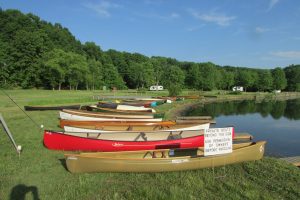For many canoeists, one thing that becomes clear shortly after learning to paddle is that you always need one more canoe. Different hull shapes and designs lend themselves to different styles and applications of canoeing… as an extreme example, a canoe that’s at its best at a whitewater playspot may not be the best canoe for a trip that includes large windy lake crossings. The one canoe perfect for all situations simply cannot exist, so we all need another one. As a paddler’s skills develop, a different canoe may offer more challenges. Also, sometimes canoes get damaged beyond reasonable repair, so replacements can become necessary.
The question then becomes, which canoe to buy next?
The criteria for buying any canoe are the same, whether it’s your first boat or your thirtieth.
- How will you use the canoe, in what kinds of conditions?
- What design elements are important to you: rocker, length, width, stem heights, others?
- To what extent are you concerned about what the canoe weighs?
- What’s your price range? Note that as weight decreases, price increases…
The list is long, and all points are quite relevant, but tend to be of varying degrees of significance to each individual paddler. That’s why test paddling any canoe you might want to purchase is so important.
 So how does one go about test paddling? Many, though not all, retailers allow test paddling in a specific pond or lake, but few allow it on rivers. Understand that you’re likely paddling a brand new product, and they don’t want it coming back all dinged up! Some retailers keep a collection of “Demo Boats”, specifically for test paddling, which are then then sold as used after a season or two. Note that Big Box stores may have the lowest prices, but won’t have test paddling. They’re not really interested in whether the boat they’re selling is the right boat for you, or if it’s safe for your intended use; they just want to sell you any boat. Buyers need to be informed and aware. Test paddling canoes on the used market may involve additional challenges, but it’s just as important as when buying a new canoe.
So how does one go about test paddling? Many, though not all, retailers allow test paddling in a specific pond or lake, but few allow it on rivers. Understand that you’re likely paddling a brand new product, and they don’t want it coming back all dinged up! Some retailers keep a collection of “Demo Boats”, specifically for test paddling, which are then then sold as used after a season or two. Note that Big Box stores may have the lowest prices, but won’t have test paddling. They’re not really interested in whether the boat they’re selling is the right boat for you, or if it’s safe for your intended use; they just want to sell you any boat. Buyers need to be informed and aware. Test paddling canoes on the used market may involve additional challenges, but it’s just as important as when buying a new canoe.
 Without doubt, the best place to test paddle a variety of canoes is at canoe events; the Western Pennsylvania Solo Canoe Rendezvous (wpascr.org) is an annual event that exists primarily to help people get on the water, and to try different canoes. Tandem canoes are always there, too. At all canoe events, there will usually be a wide variety of canoes present, and getting to try any of them is rarely more difficult than asking the owner’s permission. A common response to such requests is most likely to be “Do you want help getting it in the water?” That’s a long way of saying Yes, which is what nearly everyone is going to say…
Without doubt, the best place to test paddle a variety of canoes is at canoe events; the Western Pennsylvania Solo Canoe Rendezvous (wpascr.org) is an annual event that exists primarily to help people get on the water, and to try different canoes. Tandem canoes are always there, too. At all canoe events, there will usually be a wide variety of canoes present, and getting to try any of them is rarely more difficult than asking the owner’s permission. A common response to such requests is most likely to be “Do you want help getting it in the water?” That’s a long way of saying Yes, which is what nearly everyone is going to say…
While you’re on the water, try to practice everything you know in each boat. Make the boats go straight, forward & backward, turn left and right using all the skills you have. See if you can get comfortable in the canoe… is it too large or small for you? Does it track (go straight) easily enough, or does it turn too much on its own? Does it feel “tippy”? Do you feel like you would need more “stick time,” practicing using it, before you want to commit to buying it? Can you put it in the water by yourself, or do you need help with it? If it’s used, how much damage does it have?
Buying another canoe is always fun, but it’s better to make informed choices. You may find that a particular canoe feels “just right,” in which case the canoe is telling you something important! Exactly which canoe that is will be different for every individual. What suits one person may not suit another… personal preferences come into play in a large way. A June Bug or Flashfire will feel perfect for some people, while others will prefer a small tandem, outfitted for paddling solo. It’s all good… and make sure you have fun shopping!
